| Listing 1 - 10 of 75 | << page >> |
Sort by
|
Book

ISBN: 9781782385844 1782385843 9781782385837 1782385835 Year: 2015 Publisher: Berghahn Books
Abstract | Keywords | Export | Availability | Bookmark
 Loading...
Loading...Choose an application
- Reference Manager
- EndNote
- RefWorks (Direct export to RefWorks)
No detailed description available for "Urban Violence in the Middle East".
Urban violence-Middle East-History. --- Sociology, Urban-Middle East-History. --- City and town life-Middle East-History. --- Community life-Middle East-History. --- Political culture-Middle East-History. --- Petroleum industry and trade-Social aspects-Middle East-History. --- Social change-Middle East-History. --- Middle East-Social conditions. --- Middle East-Politics and government. --- Middle East-Colonial influence.
Book
ISBN: 1283314274 9786613314277 9027280533 9789027280534 9781283314275 6613314277 9027245096 Year: 1982 Publisher: Amsterdam/Philadelphia : John Benjamins Publishing Company,
Abstract | Keywords | Export | Availability | Bookmark
 Loading...
Loading...Choose an application
- Reference Manager
- EndNote
- RefWorks (Direct export to RefWorks)
This collection of papers deals with aspects of the history of Arabic and Hebrew linguistics. These papers appeared simultaneously in Historiographia Linguistica 8:2/3 (1981).
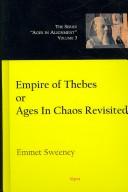
ISBN: 128139811X 0875864813 9780875864815 9780875864792 0875864791 9780875864808 0875864805 Year: 2007 Publisher: New York : Algora Publishing,
Abstract | Keywords | Export | Availability | Bookmark
 Loading...
Loading...Choose an application
- Reference Manager
- EndNote
- RefWorks (Direct export to RefWorks)
Empire of Thebes
Egypt -- History -- Errors, inventions, etc. --- Egypt -- History -- New Kingdom, ca. 1550-ca. 1070 B.C. --- Middle East -- History -- Errors, inventions, etc. --- Middle East -- History -- To 622. --- Velikovsky, Immanuel, 1895-1979. Ages in chaos. --- History & Archaeology --- Regions & Countries - Africa
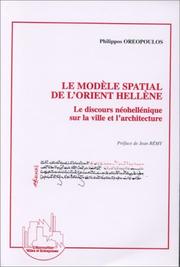
ISBN: 2738469736 9782738469731 Year: 1998 Volume: *8 Publisher: Paris: L'Harmattan,
Abstract | Keywords | Export | Availability | Bookmark
 Loading...
Loading...Choose an application
- Reference Manager
- EndNote
- RefWorks (Direct export to RefWorks)
Architecture [Byzantine ] --- Architecture byzantine --- Architectuur [Byzantijnse ] --- Cities and towns --- Architecture --- Villes --- History --- Histoire --- Communication in architecture --- Communication in city planning --- City planning --- Architecture [Greek ] --- Influence --- Greece --- Communication in architecture - Middle East - History --- Communication in architecture - Balkan Peninsula - History --- Communication in city planning - Middle East - History --- Communication in city planning - Balkan Peninsula - History --- Architecture - Middle East - History - Sources --- Architecture - Balkan Peninsula - History - Sources --- City planning - Middle East - History - Sources --- City planning - Balkan Peninsula - History - Sources
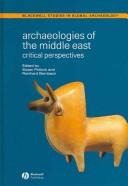
ISBN: 0631230017 0631230009 Year: 2005 Volume: 4
Abstract | Keywords | Export | Availability | Bookmark
 Loading...
Loading...Choose an application
- Reference Manager
- EndNote
- RefWorks (Direct export to RefWorks)
Archaeologies of the Middle East provides an innovative introduction to the archaeology of this fascinating region and a window on both its past and present. Written by some of the top archaeologists of the Middle East: scholars from diverse backgrounds with a wide range of interests and intellectual approaches Coverage spans 100,000 years: from the Paleolithic to Hellenistic times Explores the connections between modern-day politics and the social context of archaeological practice and various underutilized approaches to archaeological interpretation Des
Archaeology --- Archeology --- Anthropology --- Auxiliary sciences of history --- History --- Antiquities --- Middle East --- Antiquities. --- Archaeology - Middle East - History. --- Middle East - Antiquities.
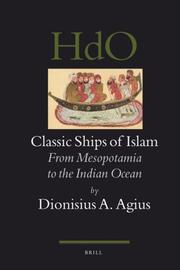
ISBN: 9789004158634 9004158634 9786611921842 128192184X 9047423828 9789047423829 Year: 2008 Volume: 92 Publisher: Leiden ; Boston : Brill,
Abstract | Keywords | Export | Availability | Bookmark
 Loading...
Loading...Choose an application
- Reference Manager
- EndNote
- RefWorks (Direct export to RefWorks)
This book charts the development of Islamic ships and boats in the Western Indian Ocean from the seventh to the early sixteenth century with reference to earlier periods. It utilizes mainly Classical and Medieval Arabic sources with iconographical evidence and archaeological finds. Maritime activities in the region resulted in a cross fertilization, not only of goods but also of ideas and culture which gave an underlying cohesion to the Arabian, Persian and Indian maritime peoples. This study has led to a re-evaluation of that maritime culture, showing that it was predominantly Persian and Indian, with Chinese influence, throughout the Islamic period until the coming of the Portuguese, as reflected in nautical terminology and technology.
Ships, Medieval --- Boats and boating --- Navigation --- Navires médiévaux --- Bateaux --- History --- Histoire --- Indian Ocean --- Indien, Océan --- History. --- Ships --- Navires médiévaux --- Indien, Océan --- Havens. --- Islamitische wereld. --- Scheepvaart. --- Schepen. --- Vessels (Ships) --- Shipbuilding --- Zuidwest-Azië. --- Ships - Middle East - History --- Boats and boating - Middle East - History --- Navigation - Middle East - History --- Indian Ocean - Navigation - History --- Navires --- Moyen-Orient --- Moyen âge --- Moyen âge
Book
ISBN: 9781782976318 1782976310 1782976329 1782976345 9781782976349 9781782976325 9781782976332 1782976337 Year: 2014 Volume: 17 Publisher: Oxford, England ; Havertown, Pennsylvania : Oxbow Books,
Abstract | Keywords | Export | Availability | Bookmark
 Loading...
Loading...Choose an application
- Reference Manager
- EndNote
- RefWorks (Direct export to RefWorks)
The history of the Ancient Near East covers a huge chronological frame, from the first pictographic texts of the late 4th millennium to the conquest of Alexander the Great in 333 BC. During these millennia, different societies developed in a changing landscape where sheep (and their wool) always played an important economic role. The 22 papers presented here explore the place of wool in the ancient economy of the region, where large-scale textile production began during the second half of the 3rd millennium. By placing emphasis on the development of multi-disciplinary methodologies, experiment
Textile industry --- Textile fabrics, Ancient --- Wool industry --- Textiles et tissus --- Textiles et tissus antiques --- Laine --- History --- Congresses --- Industrie et commerce --- Histoire --- Congrès --- Middle East --- Moyen-Orient --- Antiquities --- Congresses. --- Antiquités --- Wool --- Economic aspects --- Middle East -- Antiquities -- Congresses. --- Textile fabrics, Ancient -- Middle East -- Congresses. --- Textile industry -- Middle East -- History -- To 1500 -- Congresses. --- Wool -- Economic aspects -- Middle East -- History -- To 1500 -- Congresses. --- Wool industry -- Middle East -- History -- To 1500 -- Congresses. --- Mechanical Engineering --- Engineering & Applied Sciences --- Industrial & Management Engineering --- Congrès --- Antiquités --- Wool-growing industry --- Wool trade and industry --- Woolgrowing industry --- Fleece --- Ancient textile fabrics --- Textile industry and fabrics --- Textiles industry --- Sheep industry --- Animal fibers --- Hair --- Sheep --- Manufacturing industries --- E-books --- Textile industry - Middle East - History - To 1500 - Congresses --- Textile fabrics, Ancient - Middle East - Congresses --- Wool - Economic aspects - Middle East - History - To 1500 - Congresses --- Wool industry - Middle East - History - To 1500 - Congresses --- Middle East - Antiquities - Congresses
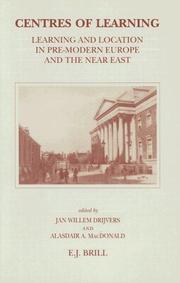
ISBN: 9004101934 9004247157 9789004101937 9789004247154 Year: 1995 Volume: 61 Publisher: Leiden ;New York E.J. Brill
Abstract | Keywords | Export | Availability | Bookmark
 Loading...
Loading...Choose an application
- Reference Manager
- EndNote
- RefWorks (Direct export to RefWorks)
Centres of Learning deals with the relation between learning and the locations in which that learning is carried out. It is the editors' belief that the character (and, in part, the content) of a particular aspect of learning is determined — or at least influenced — by the circumstances in which the learning process takes place. The contributions in this book deal with various aspects of learning, in a broad historical and geographical perspective, which ranges from Ancient Babylon, via classical Greece and Rome, and the Middle East (both Christian and Islamic), through to the Latin and vernacular cultures of the Christian West in the Middle Ages and the Early Renaissance.
Education, Ancient --- Education, Medieval --- Islamic learning and scholarship --- Learning and scholarship --- Schools --- History. --- History --- Education [Ancient ] --- Europe --- Middle East --- Education [Medieval ] --- Medieval, 500-1500 --- Education, Ancient - Europe - History. --- Education, Ancient - Middle East - History. --- Education, Medieval - Europe - History. --- Education, Medieval - Middle East - History. --- Schools - Europe - History. --- Schools - Middle East - History. --- Middle Ages, 500-1500 --- Medieval learning and scholarship --- Education --- Medieval education --- Seven liberal arts --- Civilization, Medieval
Book
ISBN: 9781139028721 9780521809658 9780521007269 9781139839785 1139839780 1139028723 9781107233447 1107233445 9781139842167 1139842161 9781139844529 1139844520 0521809657 0521007267 1139853619 1107253683 Year: 2013 Publisher: Cambridge : Cambridge University Press,
Abstract | Keywords | Export | Availability | Bookmark
 Loading...
Loading...Choose an application
- Reference Manager
- EndNote
- RefWorks (Direct export to RefWorks)
This book is about power. The power wielded over others - by absolute monarchs, tyrannical totalitarian regimes and military occupiers - and the power of the people who resist and deny their rulers' claims to that authority by whatever means. The extraordinary events in the Middle East in 2011 offered a vivid example of how non-violent demonstration can topple seemingly invincible rulers. This book considers the ways in which the people have united to unseat their oppressors and fight against the status quo and probes the relationship between power and forms of resistance. It also examines how common experiences of violence and repression create new collective identities. This brilliant, yet unsettling book affords a panoramic view of the twentieth and twenty-first century Middle East through occupation, oppression and political resistance.
Government, Resistance to -- Middle East -- History. --- Middle East -- Politics and government -- 1945-. --- Nonviolence -- Middle East -- History. --- Protest movements -- Middle East -- History. --- Government, Resistance to --- Protest movements --- Nonviolence --- Government - Non-U.S. --- Law, Politics & Government --- Government - Asia --- Non-violence --- Pacifism --- Social movements --- Civil resistance --- Non-resistance to government --- Resistance to government --- Political science --- Political violence --- Insurgency --- Revolutions --- History --- Social Sciences --- Political Science --- Political resistance --- History. --- Middle East --- Politics and government
Book
ISBN: 9780199565283 0199565287 0191721727 Year: 2009 Publisher: Oxford: Oxford university press,
Abstract | Keywords | Export | Availability | Bookmark
 Loading...
Loading...Choose an application
- Reference Manager
- EndNote
- RefWorks (Direct export to RefWorks)
This book explores the agrarian landscape and economy of the eastern Mediterranean from modern Israel to Turkey. This region experienced a surge in population between the fifth and sixth centuries AD that raised the population to levels often only regained in the late twentieth century. Cities expanded and the eastern lands reached a pinnacle of cultural expression and economic prosperity in the century before the arrival of Islam. Behind all this lay the ability of Roman farmers to feed themselves by producing a reliable surplus of food. Michael Decker describes precisely how this was done: how plants critical to survival were grown and how new plants were introduced. He also catalogues the range of intensive farming methods used and the rise of cash-crop farming based on olive oil and wine that was traded throughout Europe, western Asia, and parts of Africa.
Historic agricultural landscapes --- Paysages agricoles historiques --- Agriculture --- Farmers --- Economic aspects --- History. --- Provinces --- History --- Aspect économique --- Histoire --- Mediterranean Region --- Middle East --- Méditerranée, Région de la --- Moyen-Orient --- Roman provinces --- Rural conditions --- Commerce --- Real Estate, Housing & Land Use --- Agriculture - General --- Business & Economics --- Earth & Environmental Sciences --- Agriculture - Rome - Provinces - History --- Agriculture - Middle East - History - To 1500 --- Farmers - Middle East - History - To 1500 --- Agriculture - Economic aspects - Rome - Provinces - History --- Agriculture - Economic aspects - Middle East - History --- Roman provinces - Rural conditions --- Roman provinces - Commerce --- Middle East - History - To 622 --- Middle East - Rural conditions --- Middle East - Commerce - History
| Listing 1 - 10 of 75 | << page >> |
Sort by
|

 Search
Search Feedback
Feedback About UniCat
About UniCat  Help
Help News
News